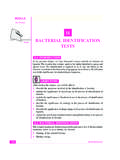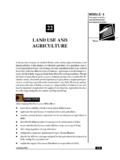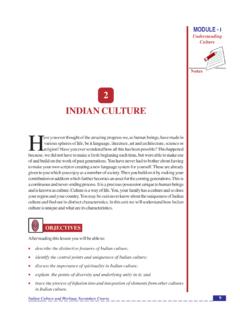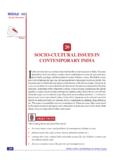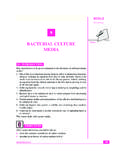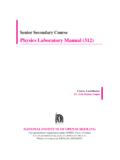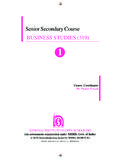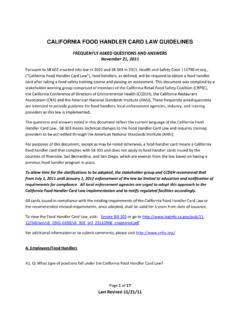Transcription of 8 COMMUNICABLE AND LIFE STYLE DISEASES
1 HOME SCIENCEMODULE - 1 COMMUNICABLE and life STYLE DiseasesHome Science in Daily life 128 Notes8 COMMUNICABLE AND LIFESTYLE DISEASESYou have learnt about the role of nutrition and environmental sanitization formaintaining goods. We all know that for happy living, it is necessary to remain healthyand free from DISEASES . However, you must have seen people suffering from disease makes a person weak and vulnerable to more suffering. Do you know thata disease , if prolonged, may also result in disability or death? DISEASES may be theresult of infection in the body such as jaundice or diarrhea.
2 They may be a result offaulty eating and living habits ( life STYLE ) like diabetes and hypertension. Many of thesediseases such as hypertension, heart disease and diabetes can only be controlled butnot cured. In this lesson, you will study about DISEASES which occur because ofinfections and faulty life STYLE . You would also learn about their prevention, cure andcontrol in order to lead a productive reading this lesson you will be able to explain the terms COMMUNICABLE and lifestyle DISEASES ; identify the causes of COMMUNICABLE and lifestyle DISEASES ; recognize the signs and symptoms of COMMUNICABLE DISEASES ; suggest measures to protect yourself COMMUNICABLE and lifestyle DISEASES ; list the factors causing life STYLE DISEASES and adopt healthy practices to maintain good IS A disease ?
3 disease is a state of discomfort in which the normal functioning of the body isaffected. The state of disease is the opposite to the state of health. Do you rememberMODULE - 1 Home Science in Daily life 129 COMMUNICABLE and life STYLE DiseasesHOME SCIENCEN oteshow health has been defined? Go back and read Lesson 7. You must have noticed thatwhen a person has a disease there are certain signs and symptoms. Each disease hasassociated signs and symptoms which are particular to that disease only. Try torecollect how you felt when you were suffering from common cold? You had a sorethroat, a blocked nose, body ache and fever.
4 However, when your grandmother hadhypertension she was restless, disoriented, and fatigued. She was advised rest andasked to avoid physical and mental stress. You have seen that in both the cases thepatient was uncomfortable. In this lesson we will discuss two types of DISEASES : COMMUNICABLE DISEASES and life STYLE IMMUNITYS ometimes it happens that your family members or friends may have viral fever butyou do not catch it? Why do you think this happens? This happens because your body sdefense system protects you from germs. In other words you had immunity to viralfever. Do you know how our defense system functions?
5 Our body s defense systemconsists of white blood cells which act as soldiers to fight germs. The white blood cellsproduce a substance called antibodies to fight germs. In the fight between theantibodies and germs, if the antibodies are able to resist and destroy the germs then theinfection is prevented and the person is said to be having immunity. However, if thegerms manage to overpower the antibodies, the symptoms of disease appear. In otherwords, the person does not have immunity to the disease . Immunity is the ability ofthe body to resist a particular disease . You have learnt about immunity andimmunization at length in Lesson COMMUNICABLE DISEASESThe DISEASES that spread from one person to the other are called CommunicableDiseases or infectious DISEASES .
6 These DISEASES are caused by infection which spreadsor is communicated through the medium of touch, sharing towel, handkerchief etc. ofthe patient, air, food or water or through sexual contact with an infected , polio, typhoid, measles, mumps, chickenpox, tuberculosis ( ), sexuallytransmitted infections and AIDS (Acquired Immuno Deficiency Syndrome) are someof the COMMUNICABLE DISEASES . What Causes COMMUNICABLE DISEASES ? COMMUNICABLE DISEASES are caused by very tiny organisms called germs and germs are present everywhere- in air, water, soil, etc. When germs enter ahealthy body, they multiply and upset the normal functioning of the body.
7 Thisproduces symptoms of a disease . If a person consumes infected food or water theHOME SCIENCEMODULE - 1 COMMUNICABLE and life STYLE DiseasesHome Science in Daily life 130 Notessymptoms of disease may not develop immediately. The germs take some time to growin sufficient numbers to produce the symptoms of the disease in body. This gap of timebetween the entry of germs into our body and appearance of symptoms of the diseaseis called the incubation person suffering from typhoid, must have consumed food infected with typhoidgerms about 2-3 weeks earlier, but the symptoms appear some time period is different for different DISEASES .
8 During this period, the person mayremain perfectly healthy but is a carrier of the How Do COMMUNICABLE DISEASES Spread?You know that germs are present everywhere around us and they can spread throughfour modes:(i)Food and water(ii)Air(iii)Contact(iv)InsectsLet us now study these in detail.(i)Food and WaterYou must have often being told to keep food and water covered. Can you say why youare told to do so? Yes, you are right. Uncovered food and water are likely to getcontaminated with germs and spread DISEASES . Do you know how else food and watercan get contaminated? It can get contaminated through:i)unhygienic conditions of preparation, serving and storingii)dirty hands and utensils andiii)houseflies which transfer germs from rubbish and garbage to water should be taken from a safe source.
9 Water which you get from themunicipal taps is safe to drink. Can you tell why? This is because tap water is cleanedand treated by certain methods that kill germs before it is sent to our homes but waterfrom wells, ponds, streams and even hand pumps is generally unsafe and may containdisease-causing germs. DISEASES such as diarrhea, hepatitis, cholera and typhoid arespread in this way.(ii)AirSuppose a person suffering from influenza, conjunctivitis or mumps, coughs or speaksloudly or sneezes- what do you think can happen? Yes, you are right. The patientthrows germs of that disease into the air which enter our body when we breathe in.
10 Sowe are likely to catch the disease . The air in crowded places, poorly ventilated housesMODULE - 1 Home Science in Daily life 131 COMMUNICABLE and life STYLE DiseasesHOME SCIENCEN otesand cinema halls is more likely to contain disease -causing germs. That is the reasonwhy we should avoid visiting crowded places when we are suffering from communicablediseases.(iii) ContactA COMMUNICABLE disease may also spread through contact, which may be: Direct contact Indirect contactDirect contact means you actually touch a person who has a disease or have sexualcontact with him/her. DISEASES like common cold, diphtheria, cholera, tuberculosis,pneumonia, measles and meningitis are caused through direct contact with the like hepatitis B, genital warts, herpes, syphilis, gonorrhea and HIV/ AIDS arecaused by sexual contact with an infected are set to have indirect contact with a patient when you use anything that he/shemay have used like a comb, towel, cup, etc.
